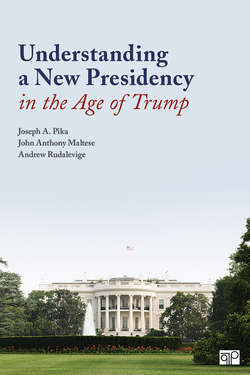Читать книгу Understanding a New Presidency in the Age of Trump - Joseph A. Pika - Страница 9
На сайте Литреса книга снята с продажи.
II. The Inauguration
ОглавлениеAlmost none of the ceremony associated with modern-day inaugurations is formally required, but it has become an important ritual intended to unite the nation behind its new leader. Planning this event is yet another challenge for any president-elect. The only constitutional requirement for the new president is to take the oath of office. Virtually everything else—taking the oath outdoors in front of a crowd, the use of a Bible during the swearing-in, giving an inaugural address, parades, balls—has emerged by way of tradition.
Modern-day inaugurations are elaborate affairs that require an enormous amount of planning. They are also very expensive. Private donations fund the inaugural balls, luncheons, and concerts. Trump raised a record $90 million to fund such events, but that is only part of the total cost.35 Security alone can cost over $100 million. Preliminary estimates put the cost of the Trump inauguration at about $200 million—the most expensive in history, even though the Presidential Inaugural Committee cut back on the number of inaugural balls, trimmed the length of the inaugural parade, and provided fewer concerts (all in the name of President Trump getting “right to work”).36 Many accounts noted that those planning the inauguration had difficulty securing major performers to participate in inaugural events amid polls showing record-low support for the president-elect, but Trump boasted that “record numbers” would attend his inauguration.37 When various metrics, including aerial photographs, indicated that the number of people attending Trump’s inauguration fell far short of the estimated 1.8 million who attended Barack Obama’s first inaugural, the president and his spokespeople pushed back. In his very first briefing, White House Press Secretary Sean Spicer accused the press of deliberately false reporting about the size of the crowd, saying, “This was the largest audience to ever witness an inauguration, period, both in person and around the globe.”38
Photo 4 President Trump delivers his inaugural address at the U.S. Capitol, January 20, 2017.
Alex Wong/Getty Images
The president’s continuing insistence that the “fake news” media had deliberately lied about the crowd size raised eyebrows, as did some of what he said in his inaugural address. Rather than using the speech as an opportunity for conciliation and unity—the themes he had highlighted on the night of his election—Trump continued to dwell on campaign tropes that stressed “us” versus “them” and the dire conditions he claimed to be inheriting. He excoriated the political establishment (“The establishment protected itself, but not the citizens of our country. Their victories have not been your victories.”), painted a bleak picture of an America beset by the “carnage” of “the crime and the gangs and the drugs,” promised that “from this day forward, it’s going to be only America first,” and reinforced fears of immigrants and terrorists (“We must protect our borders from the ravages of other countries. … We will bring back our borders … and reform the world against radical Islamic terrorism.”).39 James Fallows, a former presidential speechwriter and journalist, contrasted Trump’s tone with that of the fellow populist Trump often praised, Andrew Jackson. Jackson said in his first inaugural address in 1829:
A diffidence, perhaps too just, in my own qualifications will teach me to look with reverence to the examples of public virtue left by my illustrious predecessors, and … induces me to hope for instruction and aid from the coordinate branches of the Government, and for the indulgence and support of my fellow-citizens generally.40
President Trump made no such plea for cooperation across the branches or for broad public support, nor did he pursue such an approach in the months to come.
